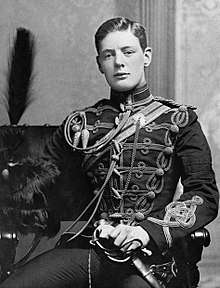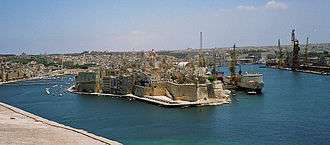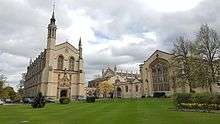Richard Stanley Hawks Moody
Colonel Richard Stanley Hawks Moody, CB (23 October 1854 – 10 March 1930) was a distinguished officer, and historian, of the British Army, during the period of the height of the British Empire. He subsequently became a Military Knight of Windsor.
Colonel Richard Stanley Hawks Moody CB | |
|---|---|
%2C_3rd_Regiment_of_Foot%2C_c.1885.png) Richard Stanley Hawks Moody, before his departure to Malta in 1885. | |
| Born | 23 October 1854 Strada Reale, Valletta, Malta |
| Died | 10 March 1930 |
| Allegiance | |
| Service/ | |
| Rank | Colonel |
| Commands held |
|
| Battles/wars | |
| Awards |
|
| Alma mater | Royal Military College, Sandhurst |
| Relations |
|
He was the eldest son of Richard Clement Moody, the founder and first Lieutenant-Governor of British Columbia, and of Mary Hawks of the Hawks dynasty.
Birth and family
Hawks Moody was born in Strada Reale, Valletta, Malta on 23 October 1854, the eldest son of Major General Richard Clement Moody, the first Governor of the Falkland Islands and founder and first Lieutenant-Governor of British Columbia,[1][2][3] and Mary Susannah Hawks[4] of the Hawks industrial dynasty, daughter of merchant banker Joseph Hawks JP DL,[5] Sheriff of Newcastle,[6] and Mary Boyd of the Boyd merchant banking family. Mary Hawks's maternal uncles included Admiral Benedictus Marwood Kelly and industrialist Edward Fenwick Boyd.[7] The Moody family had a distinguished history of military service in the British Empire.[8] Hawks Moody's paternal grandfather was Colonel Thomas Moody, JP, Knight of the Order of Military Merit of France,[9][10][11] and his uncle was Colonel Hampden Clement Blamire Moody CB, Commander of the Royal Engineers in China during the Second Opium War[12] and the Taiping Rebellion.[13][14]
Early life
Hawks Moody was born, on 23 October 1854, in Malta, where his father was Commanding Executive Officer of the Royal Engineers,[3] and spent his infancy in the British Columbia, of which his father was founder and Lieutenant-Governor.[1][2][3] Hawks Moody is regularly mentioned in the letters written by his mother, Mary Hawks, to England from various colonies of the British Empire.[15][16] Hawks Moody and his brothers were educated in England at Ludlow Grammar School[17] and Cheltenham College.[4][18] After Cheltenham, Hawks Moody was granted a direct commission, as a sub-lieutenant, in the 3rd Regiment of Foot, on 9 August 1873.[19][4][20] Subsequently, he passed the Staff College, Camberley.[4][20]
Military service
Anglo-Zulu War
Hawks Moody served in the Anglo-Zulu War, in 1879, as an adjutant, in Zululand, with the 2nd Battalion of the 3rd Regiment of Foot.[4][21]
India and Pakistan


Between 1895 and 1897, Hawks Moody served in the Chitral Expedition, in which he was part of General William Forbes Gatacre's flying column.[4]
Hawks Moody was part of the Malakand Field Force in 1897, during which he was second in command of 3rd Regiment of Foot under General Sir Bindon Blood, after whom he named his youngest daughter, Barbara Bindon. During this conflict, Hawks Moody was mentioned in dispatches,[4] and fought alongside Winston Churchill, who mentions him in Chapter XII (At Inayat Kila) of his history of the conflict, The Story of the Malakand Field Force.[22]
Second Boer War
Between 1899 and 1902, Hawks Moody served in the Second Boer War, for which he was mentioned in dispatches at least twice.[4][23] He was promoted to lieutenant-colonel on 24 February 1900 to command a battalion of the Royal Munster Fusiliers,[24] which was not raised, so he was sent to South Africa on special service, and commanded the 2nd battalion of the Royal Irish Fusiliers, from January 1901 to end of campaign. In this position he was again mentioned in despatches. Following the end of the war in June 1902, he returned to England on the SS Custodian, and landed at Southampton in August 1902.[25] For his service in this conflict he was appointed a Companion of the Order of the Bath (CB) in the South Africa honours list, which was published on 26 June 1902,[26] and he received both the Queen's and King's medals with 5 clasps.[4] He received the actual decoration of CB from King Edward VII after his return, during an investiture at Buckingham Palace on 24 October 1902.[27]
World War One
Hawks Moody initially retired from the Army in 1906, subsequent to which he was appointed Commander of the Devon and Somerset Brigade of the Territorial Army, a position that he held until 1910.[28]
After the outbreak of World War One in 1914, he rejoined active service and raised[28] the 7th Battalion Royal Irish Fusiliers,[4] of which he served as Colonel. During the conflict he also served as Colonel of 2nd Battalion Royal Irish Fusiliers[4] and, in 1915, Commandant of a School of Instruction for Officers at Dover.[4] In 1916, he raised, from the Devonshire Regiment, and took to France,[28] as Commander, a battalion of the Labour Corps, which he commanded from 1917[29] to 1918, after which he retired again from active service.[30]
Military Knight of Windsor and Historian
Hawks Moody was appointed an honorary Colonel of the Buffs (East Kent Regiment) and a Military Knight of Windsor in 1919.[28][4] He was a member of the Naval and Military Club.[31]
Whilst a Military Knight, Hawks Moody, at the request of The Buffs,[28] wrote The Historical Records of The Buffs (East Kent Regiment), 3rd Regiment of Foot, 1914–1919, which was published in 1923.[32][33] He gave the first copy of the book to the Royal Library, Windsor, in 1922.[34]
Hawks Moody lost his brother, Henry de Clervaulx Moody, in the Second Boer War,[35] and his only son, Thomas Lewis Vyvian Moody, in the First World War (see below).
Hawks Moody died on 11 March 1930 at Windsor Castle. He is buried at All Saints' Churchyard in Monkland, Herefordshire, where there is a memorial to him, his sister, Gertrude, and his son, Thomas Lewis Vyvian Moody.
Marriage
In 1887, Hawks Moody married Mary Latimer[4] (d.1936), who was the daughter of John Latimer Esq., of Leeds.[28][36][37] Hawks Moody's father-in-law was the son of Anne Moody, who was the daughter of Dr. George Moody, who was the brother of his grandfather, Colonel Thomas Moody, Kt..[37] Hawks Moody's own maternal uncle was Nichol Latimer,[37] the manager of Russell & Company's Shanghai Steam Navigation Co. and the publisher of the North China Herald, the most influential British newspaper in treaty-port China.[38][39]
Hawks Moody and Mary Latimer had four children:[4]
- Mary Latimer (b.1883, d.1960). Married Major-General James Fitzgerald Martin at Exeter Cathedral, in 1906,[40] and had one daughter, Mary Charlotte (b.1909).
- Margaret (b.1886, d. unknown). Married Arthur Graham Brown, in 1914, and had two sons, George Arthur and Thomas Lionel Vyvian. Thomas Lionel Vyvian was educated at Cheltenham College and Royal Military Academy, Woolwich before receiving a commission in the Royal Engineers,[41] with whom he went to Egypt with the 1st Armoured Division. He received the George Medal for service on the Agedabia El Aghelia Road on 17 January 1942.[42]
- Thomas Lewis Vyvian[43] (b. 4 November 1896,[44] India, d. 21 March 1918, killed in action).[45][46] He was educated at Cheltenham College,[44] Eastbourne College,[43][44] and Royal Military Academy, Sandhurst.[43] Subsequent to leaving Eastbourne College, Moody served on HMS Worcester, with the Royal Indian Marine Service, until the outbreak of the First World War in 1914, whereupon he entered the Australian Army at Melbourne.[43] He served with the 8th battalion of the Royal Warwickshire Regiment during the Gallipoli Campaign.[43][44] Subsequent to his wounding at Gallipoli, he resigned his commission to enter Royal Military College, Sandhurst, from which he graduated, and was subsequently commissioned, as Lieutenant, in the 1st battalion of Buffs (Royal East Kent Regiment),[45] with which he served on the Western Front from July 1916.[43][45][44] On the Western Front, whilst in command of two platoons surrounded by German troops, Thomas was shot by a German officer with a revolver whilst leading his men in an attempt to break through the enveloping German forces.[43][47] He is commemorated at the Arras Memorial, France.[45][46][45] He died unmarried and without issue.
- Barbara Bindon[48] (b. 1903, India, d. 1973). Barbara married the choral conductor James William Webb-Jones on 20 December 1930,[49] at Parish Church, Windsor, and had one daughter, Bridget (b. 5 September 1937) who married the musician Peter S. Lyons at Wells Cathedral in 1957.[50][51]
Published works
- Hawks Moody, Colonel Richard Stanley (1922). The Historical Records of The Buffs (East Kent Regiment), (3rd Regiment of Foot), formerly designated the Holland Regiment and Prince George of Denmark's Regiment, 1914 – 1919. Medici Society, London.
References
- Minutes of the Proceedings of the Institution of Civil Engineers, Volume 90, Issue 1887, 1887, pp. 453–455, OBITUARY. MAJOR-GENERAL RICHARD CLEMENT MOODY, R.E., 1813–1887.
- Edward, Mallandaine (1887). The British Columbia Directory, containing a General Directory of Business Men and Householders…. E. Mallandaine and R. T. Williams, Broad Street, Victoria, British Columbia. p. 215 in New Westminster District Directory.
- "The Royal Engineers: Richard Clement Moody".
- "Entry for MOODY, Colonel Richard Stanley Hawks, in Who Was Who (A & C Black, Bloomsbury Publishing plc, 1920–2016)".
- "Letters of Mary Moody, Royal British Columbia Museum Archives" (PDF). Retrieved 4 July 2016.
- Fordyce, T. (1866). Local Records : or, Historical Register of Remarkable Events, which have occurred in Northumberland and Durham, Newcastle-upon-Tyne, and Berwick-upon-Tweed from the Earliest Period of Authentic Record to the Present Time [...] T. Fordyce, Newcastle upon Tyne. p. 172.
- Howard, Joseph Jackson (1893–1906). Heraldic Visitation of England and Wales. 8. pp. 161–164..
- Rupprecht, Anita (September 2012). "'When he gets among his countrymen, they tell him that he is free': Slave Trade Abolition, Indentured Africans and a Royal Commission". Slavery & Abolition. 33 (3): 435–455.
- "The Royal Engineers: Colonel Richard Clement Moody". Retrieved 3 November 2016.
- Dorothy Blakey Smith, ed., ‘The Journal of Arthur Thomas Bushby, 1858–1859,’ British Columbia
- "The Sapper Vol. 5 No. 1 June 1958". Retrieved 4 July 2016.
- War Office of Great Britain (1863). Return to an Address of the Honourable The House of Commons, dated 25 June, 1863 : for, "Copy of the Correspondence Between the Military Authorities at Shanghai and the War Office Respecting the Insalubrity of Shanghai as a Station for European Troops:" "And, Numerical Return of Sickness and Mortality of the Troops of All Arms at Shanghai, from the Year 1860 to the Latest Date, showing the Per-centage upon the Total Strength". p. 107.
- Colburn's United Service Magazine and Naval and Military Journal. 1869. p. 605.
- Meehan, John D. Chasing the Dragon in Shanghai: Canada's Early Relations with China, 1858–1952. p. 17.
- "Letters of Mary Moody, Royal British Columbia Museum Archives" (PDF). Retrieved 4 July 2016.
- "Imperial Relations: Histories of family in the British Empire, Esme Cleall, Laura Ishiguro, and Emily J. Manktelow". Project Muse. Retrieved 4 July 2016.
- "Boer War Memorial, Ludlow College".
- Hunter, Andrew Alexander (1890). Cheltenham College Register, 1841–1889. George Bell and Sons, London. p. 271.
- "No. 24006". The London Gazette. 8 August 1873. p. 3703.
- "Obituary of Colonel R. S. H. Moody, The Times, 14 March 1930".
- "Officers and Commanders". Historic Canterbury. Retrieved 6 June 2016.
- Churchill, Winston L. Spencer (1898). The Story of the Malakand Field Force: an episode of frontier war, CHAPTER XII: AT INAYAT KILA. London, UK: Longmans, Green.
- "Mentions in despatches – Army". Anglo-Boer War.
- "No. 27168". The London Gazette. 23 February 1900. p. 1260.
- "The Army in South Africa – troops returning home". The Times (36826). London. 22 July 1902. p. 11.
- "No. 27448". The London Gazette (Supplement). 26 June 1902. pp. 4191–4192.
- "Court Circular". The Times (36908). London. 25 October 1902. p. 8.
- "Obituary of Colonel Richard S. H. Moody, Windsor Paper, July 1930, 'Newspaper cuttings concerning St. George's Chapel and Military Knights of Windsor', Reference No.:SGC M.1042, College of St. George, Windsor Castle". Dean and Canons of Windsor. 1930.
- "No. 30183". The London Gazette (Supplement). 13 July 1917. p. 7080.
- "No. 30839". The London Gazette (Supplement). 9 August 1918. p. 9443.
- Hunter, Andrew Alexander (1890). Cheltenham College Register, 1841–1889. George Bell and Sons, London. p. 271.
- "Bibliography for Introduction to Military History (Part1)". University of Kent. Retrieved 6 May 2016.
- "The Historical Records of The Buffs (East Kent Regiment), 3rd Regiment of Foot, 1914–1919, Naval and Military Press".
- "Royal Collection Trust: R. S. H. Moody, Historical Records of The Buffs, East Kent Regiment (3rd Foot) […]".
- "Colonel Moody's family". Royal Engineers. Retrieved 6 June 2016.
- Marriage Announcement, The Times, 8 November 1881
- "York City Archives", York, UK: "Pedigree of Latimer and Moody Families"
- He, Sibing (2011). Russell and Company in Shanghai, 1843–1891:U. S. Trade and Diplomacy in Treaty Port China. Hong Kong University. p. 11.
- King; Clarke, eds., Frank H. H.;Prescott (1965). A Research Guide to China Coast Newspapers, 1822–1911. East Asian Research Centre, Harvard University. pp. 77, 122–133.CS1 maint: multiple names: authors list (link) CS1 maint: extra text: authors list (link)
- "Entry for MARTIN, Major-General James Fitzgerald, in Who Was Who (A & C Black, Bloomsbury Publishing, London)".
- "No. 34813". The London Gazette (Supplement). 19 March 1940. p. 1614.
- Bath Chronicle and Weekly Gazette, Somerset, England, 6 March 1943: Military Register
- "Eastbourne College Roll of War Service, 1914 – 1918, p. 40 – 41, Cambridge University Press, 1921".
- "The Court Journal, 5 July 1918". Cite magazine requires
|magazine=(help) - "Casualty Details: Moody, Thomas Lewis Vyvian". Commonwealth War Graves Commission. Retrieved 9 December 2016.
- "Arras Memorial, Every Man Remembered, Profile for Thomas Lewis Vyvian Moody".
- "No. 30559". The London Gazette (Supplement). 5 March 1918. p. 2871.
- "Engagement Announcement of James William Webb-Jones and Barbara Bindon Moody". Engagements. The Times. London. 3 July 1930.
- "WEBB-JONES, James William (1904–1965)". Who's Who, Oxford Index. Oxford University Press.
- Entry for Lyons, Peter S., Register of Twentieth Century Johnians, Volume I, 1900–1949. St John's College, Cambridge.
- 'Obituary of Peter S. Lyons, Rutland and Stamford Mercury, Friday, 20 April 2007.
Further reading
- "Entry for MOODY, Colonel Richard Stanley Hawks, in Who Was Who (A & C Black, Bloomsbury Publishing plc, 1920–2016)".
- "Obituary of Colonel Richard S. H. Moody, Windsor Paper, July 1930, 'Newspaper cuttings concerning St. George's Chapel and Military Knights of Windsor', Reference No.:SGC M.1042, College of St. George, Windsor Castle". Dean and Canons of Windsor. 1930.

